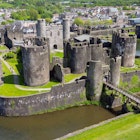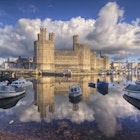
Jun 24, 2025 • 7 min read
Conwy has one of the best-preserved medieval fortifications in Britain. Here's what you need to know when you visit Conwy Castle in Wales.

Jun 24, 2025 • 7 min read
Conwy has one of the best-preserved medieval fortifications in Britain. Here's what you need to know when you visit Conwy Castle in Wales.

Jun 18, 2025 • 12 min read
For some visitors, Wales is all about the outdoors – but for others, it's all about the history. Here’s a guide to the best historic sights in Wales.

Jun 17, 2025 • 10 min read
It isn’t just the landscape that is wild and untamed in Wales. From seal spotting to dolphin encounters, here are the best wildlife experiences in Wales.

Jun 16, 2025 • 8 min read
Whether you want to hurl yourself off a seacliff into the ocean or paddle down a river, Wales is the place for outdoors adventures.

Jun 13, 2025 • 9 min read
Here's everything you need to know about hiking up Pen-y-Fan, the tallest peak in Brecon Beacons National Park and one of Wales' wildest walks.

Jun 11, 2025 • 9 min read
Set off on this three-day itinerary from Swansea to take in beaches, history and hikes on Wales’ scenic Gower Peninsula.

Apr 24, 2025 • 13 min read
See the best of Wales' landscapes with these top hiking routes, from short loops to long-distance trails.

Apr 21, 2025 • 5 min read
The main factors that will determine when to visit Wales are your budget, your tolerance for rain, and the activities you'd like to do.

Apr 15, 2025 • 11 min read
Hike with sheep, sip gin at a microdistillery, gaze up at the skies and take in countless castles: Wales offers adventures aplenty.

Apr 10, 2025 • 9 min read
Here are the top road trips in Wales, where you'll enjoy glacier-sculpted peaks, wave-bashed cliffs and brooding mountains.

Mar 20, 2025 • 12 min read
Rugged mountains, wave-smashed coasts, exciting cities and castles galore: small but mighty Wales has many places that enchant visitors.

Sep 27, 2023 • 7 min read
Take inspiration from a legendary Welsh leader as you tackle this 135-mile trail through the heart of Wales.

Aug 10, 2023 • 6 min read
Cornwall hogs Britain’s coastal limelight, but Pembrokeshire is just as heart racingly beautiful

Nov 25, 2021 • 6 min read
Whether you prefer to travel by rail, bike, bus, or car we can help you plan your trip to Wales with these top tips for getting around.

Oct 19, 2021 • 5 min read
From vast belts of golden sand and rolling surf to under-the-radar bays, the best beaches in Wales are impressive in any weather and wonderfully unspoiled.

Aug 25, 2021 • 6 min read
With soaring peaks, pristine coastlines and ancient castles, Wales’ national parks are perfect for adventurous families, hikers and history buffs.

Jan 21, 2021 • 9 min read
Filled with coastal walks, medieval castles and one very famous sign, here's our guide to a perfect weekend in Anglesey, Wales.

Nov 13, 2020 • 5 min read
Wales may have a reputation for being rainy, but don't let that stop you. Here are some of the best things to do there in winter.

Aug 14, 2020 • 4 min read
With epic coastlines, hidden coves, misty mountains and everything in between, here are the top natural wonders in the UK.

Mar 5, 2020 • 4 min read
Steeped in history and local lore, and with miles of rugged beaches, North Wales is one of the UK's must-see destinations.

Nov 15, 2019 • 5 min read
Discover the delights of one of the most popular foodie extravaganza's in the UK with our guide to Abergavenny Food Festival.

Nov 13, 2019 • 5 min read
Escape the stress of daily life with our selection of the best wellness retreats in Wales.